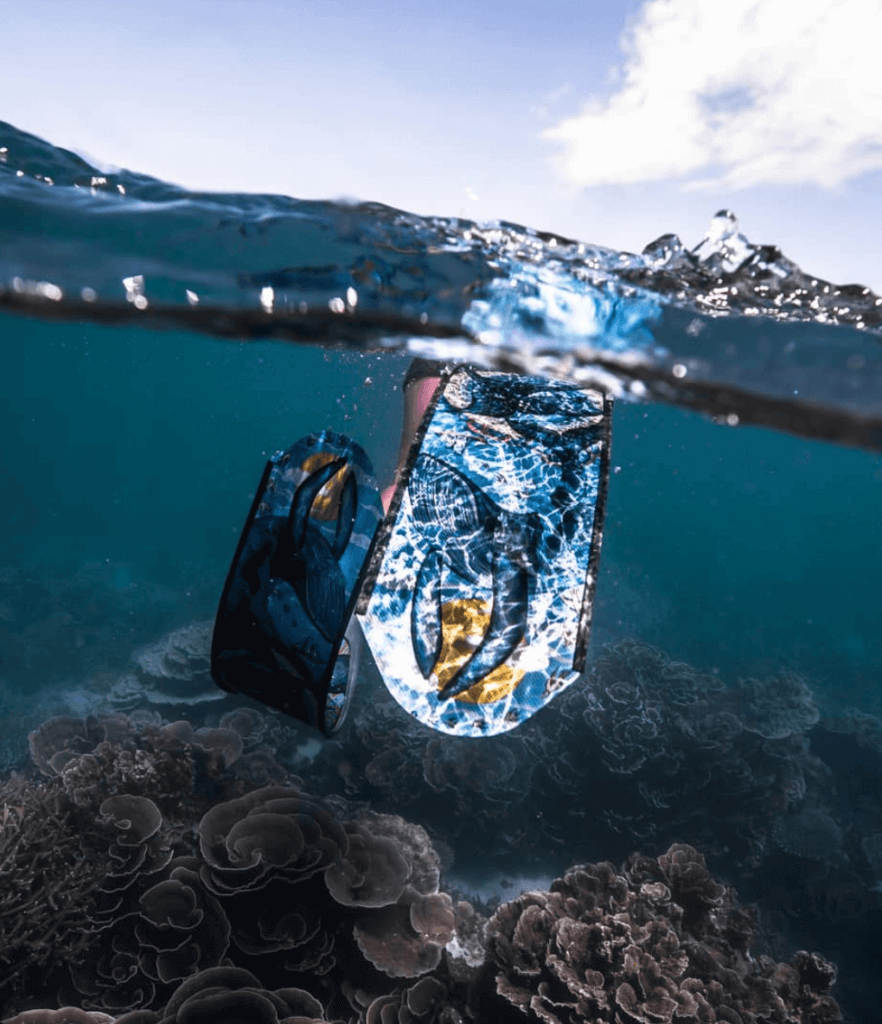
Your fins are your motor, and correct technique prevents cramping, and maximises the effectiveness of long fins. Spearfishers use long fins because (if used correctly), they are more powerful and efficient than shorter fins, or Scuba diving fins.
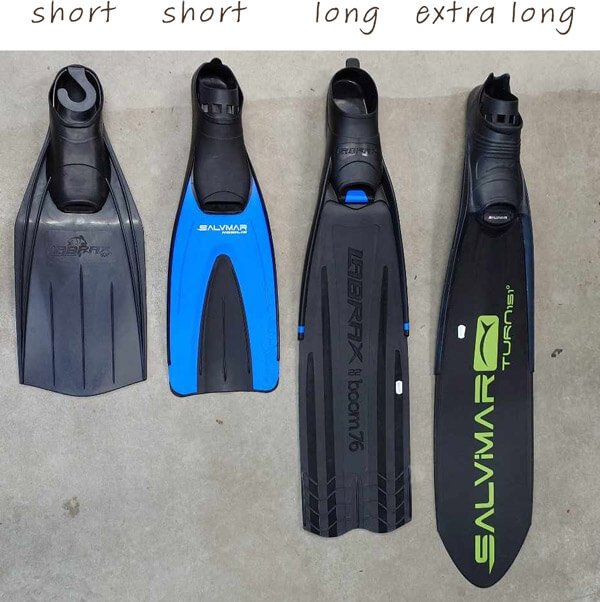
Spearfishing fins are full foot fins, so traditionally they are worn with 2 – 5mm neoprene socks, not Scuba diving boots with a strap around the heel. This closeness of the fit ensures the maximum amount of power transference from your leg down through the fin.
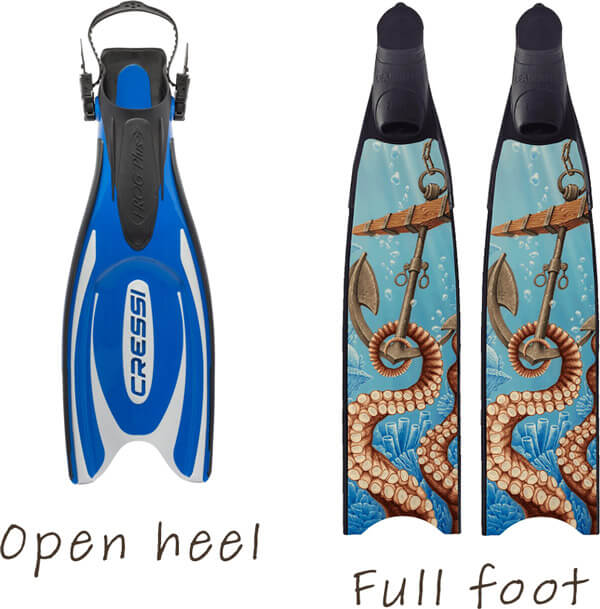
The blade is often at an angle, so that when your legs are straight, the fins are still in line with the rest of the body (see below).
In terms of materials, the blades are usually made from different plastics, fibreglass, or carbon fibre. They also come in different stiffnesses. Just because one make and model of fin works for one diver in one location, does not mean that it will work for you.
💦 Always rinse and dry your fins after use, and store them carefully out of direct sunlight. If you look after your fins then they will last decades.
When you think about how to use your fins, look at how we walk. When we walk, our legs are mostly straight, and travel an equal distance in front of the body and behind.
- We don’t bend our legs at the knee and kick the lower leg up and back toward the bottom,
- We don’t walk as if we are cycling, and
- We don’t bend the leg and bring the knee up towards the chest.
When we fin, we want to mimic how we walk – the speed, the straightness of the legs, the amplitude, and the equal distance in front and behind the body.
However, when spearfishers start out with long fins, their technique is usually very poor. As well as making the mistakes listed above, they fin too fast, as if they were swimming without fins on the surface of the water. The biggest issue people have when they first put on long fins is that they require a lot of effort to displace the water when you bring your leg in front of your body. It is easier to bring the legs back behind you, but more challenging to bring them forward, and this is why beginners bend their legs, cycle them, or bring their knees up towards their chest.
Because beginner spearfishers usually do not have an equal forward and backwards stroke (only the backwards stroke is effective or in existence), the body will not descend vertically in the water. You may be on the surface and spot a fish, or a good place to hide and wait, but if you do not have a strong forward stroke, then by the time you reach the correct depth, you will be far away from your target location. When learning, it is incredibly useful to learn by diving down a shot line. By using a line as a guide it is obvious to see if you are descending straight or not. This is one aspect of a free dive course that even seasoned divers often benefit from.
The most important thing you can think about when starting to fin, is to concentrate on the forward fin stroke.
- Keep your legs straight,
- Point your toes, and
- Focus on the movement of your fins as they come out in front of you.
It is helpful to practice finning on the surface, with your body vertical and your head out of the water. If you fin correctly in this position then you will not move. If you do not have a sufficient forward stroke then you will face-plant forwards. Do not ‘fix’ this problem by bending the knees. Always remember that your finning should be an approximation of walking.
Also, make sure that you have the right fins for your conditions.
- The foot pocket should be comfortable and close fitting enough that it is not loose – however, not so tight that it causes cramp.
- The stiffer the blade, the more power – however it will be harder to move through the water as they flex less and ultimately you burn more energy.
If you are strong, heavy and going for depth then a slightly stiffer fin may be more appropriate – however, if you are doing a lot of surface swimming to get to your hunting location, or are continuously fighting a current, then a softer fin is likely to be a better choice.
Carbon fibre usually offers the most effective material for a fin – however, this is not always the case and they need relatively careful handling. A good quality plastic blade is more effective than a poor quality or too-stiff carbon one.
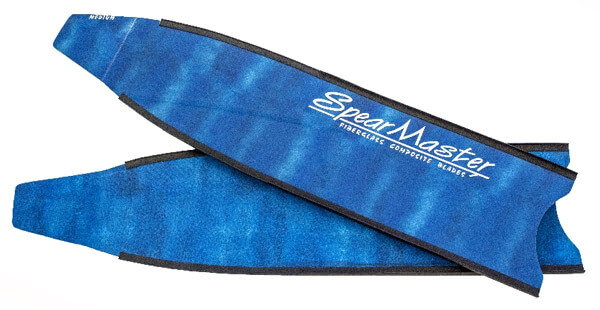
Above: Spearmaster Fibreglass Fins // “If you are wanting to improve your depths or swim further but are on a bit of a budget then fibre fins are the way to go.” ~ Chris
If you know that you are going to have to travel long distances, then it is often a worthwhile investment to get a body board style float. With these, you put your upper body on the float and your legs fin behind it. Not only does the use of a float reduce the surface resistance and make your job easier, but being up on the float angles your legs more easily under the water, which means your fins produce more power rather than flapping about on the surface.
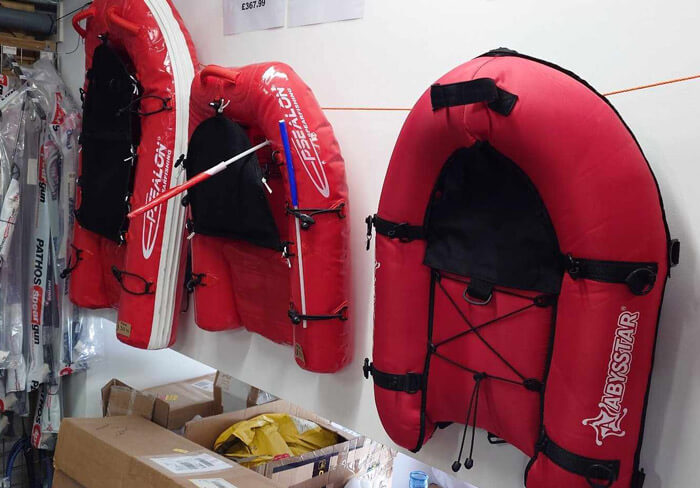
Above: The mini boat style floats – Epsealon patrol, Epsealon mini patrol, Abysstar float board // “With these you can get your bodyweight out the water and skim along the surface much easier. You can also carry extra gear and safety bits on them too like your phone, GPS, an extra gun, spare snorkel etc etc. A true game changer, you will never go back to a normal float again!” ~ Chris
If you don’t have a float and need to make headway in a strong current then you will need to engage the hips more. This uses more energy but is helpful when you need more “oomph”. You can also try finning on your back, so that your fins are more under the water. If you are not using a float, then you need to keep checking where you are going as you will quickly veer off course if you don’t.
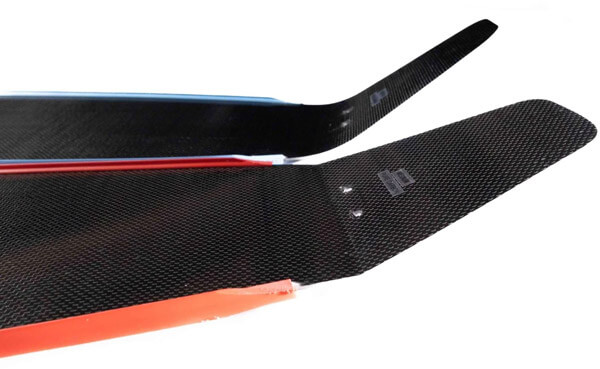
Leaderfins, showing the blade at an angle (source)
When deciding on the right fins for you, it is also important to consider the angle between the foot pocket and the blade. Unless we are ballerinas, it is impossible or uncomfortable to keep the toes pointed so that the fin blade is an extension of the leg and in line with it. As a result, fin manufacturers create an angle between the foot pocket and the blade, so that when people fin, or are at rest, the fin follows the same plane as the rest of the leg. When you are underwater, this also helps with streamlining. The bigger the angle, the less you have to point the toes when you fin. However, this does not necessarily mean that a bigger angle is the best option for you. Experiment with different blades and get your friend to critique your finning. In addition, you can get your buddy to film you so you can analyse your technique afterwards and find ways to improve.
Make sure you let the fin blade finish the stroke before you start the next one – let the fins do their work. This will also help to give you a steady and even stroke rate. Try and visualise the tips of the fins completing the arc of the stroke before you bring them back in the opposite direction. Always try and keep your legs straight and your fin stroke wide and relaxed. Count the amount of fin strokes you take to get to a set depth and see if you can reduce them. There shouldn’t be a cessation of movement between the forward and back stroke, but the finning should be relaxed,
You may feel that your body is rolling from side to side. There may be a slight rolling of the hips but it should not be obvious – remember that you don’t walk around on land like a 🤠 swaggering cowboy, so your finning doesn’t need to look like this under the water. Often this issue is connected to the diver scissoring their legs when they fin – the left leg will splay and angle out to the left and the right will splay and angle out to the right. Spearfishers will often say they do this to avoid the fins touching each other. However, this will only happen if you are pigeon-toed. Fin with your hips level and your legs in the same plane. You may need to start with very soft fins to perfect the technique and build up ankle strength before you move to a stiffer fin.
Key elements for successful finning with long fins:
- Choose the correct fitting fins with the right blade strength for your spearfishing conditions
- Keep your legs straight – there will always be a slight bend in the leg, but unless you focus on keeping your legs straight, most people will bend their legs too much
- Only think about the forward stroke of the fin – as your leg comes out in front of the body
- Have a wide amplitude
- Have a relaxed cadence
- Keep your hips level
- Let the blade finish the stroke before retraction
Next steps:
- Click here to check out Chris’s Ultimate Spearfishing and Freediving Fin buy guide
- Click here to view all of our fins and give our shop team a shout if you need some advice!
